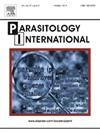菲律宾吕宋岛吕宋岛吸血猴(Boulenger, 1896)(两栖类:鼠科)中吕宋河鼠(Rhabdias luzonensis n. sp.)的分子和形态特征
IF 1.5
4区 医学
Q3 PARASITOLOGY
引用次数: 0
摘要
根据从菲律宾吕宋岛的吕宋蛙(Sanguirana luzonensis)中采集的6个标本,描述了一种肺栖线虫Rhabdias luzonensis n. sp.。新种很容易与发生在东亚和东南亚的同类线虫区分开来,因为它的颊囊结构非常独特,由前部厚壁部分和后部薄壁部分组成;两部分的长度相似。吕宋Rhabdias luzonensis是在菲律宾发现的该属的第三种,也是在该群岛两栖动物中发现的第一种。利用核rDNA (ITS区+部分28S基因)研究了该新种与其他Rhabdias属动物的系统发育关系。我们的系统发育分析将新物种置于一个包含来自不同地理区域的几个物种的分支中,并表明在几个科甚至几个目的两栖动物中明显广泛的进化宿主转换。鉴于我们发现了菲律宾青蛙特有的第一个Rhabdias,剩余的120种两栖动物(约80%是地方性的)应该是有针对性的调查的重点,目的是在未来的实地研究中表征未记录的蠕虫多样性。该新物种和几个系统发育和地理上最接近的同源物种已经生成了线粒体cox1和12S基因的部分序列,目的是为了物种分化,并为未来在菲律宾和其他东南亚群岛的Rhabdias生物多样性调查提供分子物种鉴定。本文章由计算机程序翻译,如有差异,请以英文原文为准。

Molecular and morphological characterization of Rhabdias luzonensis n. sp. (Nematoda: Rhabdiasidae) from Sanguirana luzonensis (Boulenger, 1896) (Amphibia: Ranidae) from Luzon Island, Philippines
A lung-dwelling nematode Rhabdias luzonensis n. sp. is described based on 6 specimens collected from the Luzon frog, Sanguirana luzonensis, on Luzon Island, Philippines. The new species is readily distinguishable from congeneric nematodes occurring in eastern and south-eastern Asia by the very distinct structure of the buccal capsule which consists of anterior thick-walled portion and posterior thin-walled portion; both parts are similar in length. Rhabdias luzonensis is the third species of the genus described from Philippines and the first species described from amphibians of this archipelago. Phylogenetic relationships of the new species and other Rhabdias spp. have been studied using nuclear rDNA (ITS region + partial 28S gene). Our phylogenetic analysis placed the new species in a clade containing several species originating from disparate geographic regions and demonstrating apparent widespread evolutionary host-switching among several families and even orders of amphibians. Given our discovery of the first Rhabdias specific to Philippine frogs, the remaining 120 species of amphibians (∼80 % endemic) native to this archipelago should be the focus of targeted surveys aimed at characterizing undocumented helminth diversity during future field studies. Partial sequences of mitochondrial cox1 and 12S genes have been generated for the new species and several phylogenetically and geographically closest congeners for the purpose of species differentiation and facilitate molecular species identification in future surveys of Rhabdias biodiversity in the Philippines and other SE Asian archipelagos.
求助全文
通过发布文献求助,成功后即可免费获取论文全文。
去求助
来源期刊

Parasitology International
医学-寄生虫学
CiteScore
4.00
自引率
10.50%
发文量
140
审稿时长
61 days
期刊介绍:
Parasitology International provides a medium for rapid, carefully reviewed publications in the field of human and animal parasitology. Original papers, rapid communications, and original case reports from all geographical areas and covering all parasitological disciplines, including structure, immunology, cell biology, biochemistry, molecular biology, and systematics, may be submitted. Reviews on recent developments are invited regularly, but suggestions in this respect are welcome. Letters to the Editor commenting on any aspect of the Journal are also welcome.
 求助内容:
求助内容: 应助结果提醒方式:
应助结果提醒方式:


